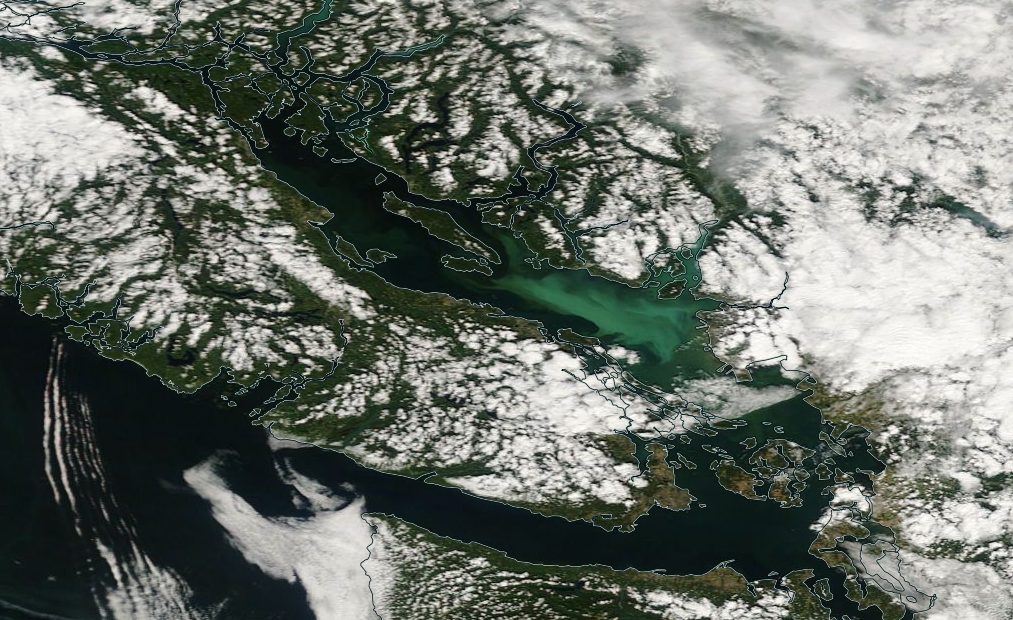 Daily Brew
Daily BrewGreen water off southern B.C. triggering questions, concerns

[A screen shot of NASA satelite imagery shows green waters off Vancouver Island on Aug. 22, 2016. NASA WORLDVIEW]
When the pool turned green at the Rio Olympic Games, the mystery took a few days to solve. In the meantime, some divers complained of itchy eyes. It was finally discovered that a worker had dumped 80 litres of hydrogen peroxide in the water neutralizing the chlorine.
Officials say there was no harm to the athletes. In the end, they had to drain one green pool and transfer nearly 3.8 million litres of “clear” water from a practice pool.
Now, closer to home, the waters from the southern Gulf Islands in British Columbia, up the Strait of Georgia and Howe Sound have turned green. And unlike Rio, the cause of it could be an alarming indication of something worse.
Conservationist Ric Careless, co-founder of the Sierra Club B.C. and head of B.C. Spaces for Nature, told the Vancouver Sun that he’s “never seen anything like this.”
Living in the area of Howe Sound for 30 years, Careless should know. He also postulates that with the heat wave, the Pemberton Icefield, measuring 300 square kilometres, is probably melting faster.
Glacier melt can cause water to look green because it will have bits of rock and minerals in it and light from the sun hitting these particles could “change” the water’s colour.
Algae that is ‘harmless’?
Not so fast says Nicky Haigh, who leads the Harmful Algae Monitoring Program at Vancouver Island University in Nanaimo. Haigh has the answer.
“It’s an algae bloom of coccolithophorids and they are the dominant species in the water right now,” she told Yahoo Canada News. “These species have calcium carbonate scales, so they make the water chalky but the scales also reflect off the colours of other algae, which are greenish-blue.”
Haigh, who studied oceanography and geography, says her organization tested the water and confirmed that it was the tiny algae, which she says are “harmless.”
“You might even like to swim in the water more because the calcium carbonate scales make it softer,” she noted. “Nothing will happen to you if you are in the water.”
But there are some dark clouds looming over the innocent bloom. Though these blooms of coccolithophorids are common around the world, Haigh says she doesn’t have any historical report of them appearing in such a mass around the Strait of Georgia and other areas nearby.
“The phytoplankton/algae do bloom if they have right the temperature, salinity and light levels in the water. In terms of warmer water this year, it hasn’t been that much more than previous years when it was hot.”
Acidification a worry
Haigh though does surmise that the increasing acidification of ocean waters due to climate change does mean more algae.
“In Vancouver Island, we are seeing more acidic waters over the last decade,” she explained. “So this is a reflection of climate change and the increasing deterioration of the world’s oceans.”
Haigh said this has an effect on species and how they grow. It’s all about the food chain.
“Over in Puget Sound, Washington state, people are now shipping larval shellfish to Hawaii because they can’t [thrive and grow] in the waters off the state. And the growers are then shipping them back to Washington state for the rest of the time.”
Haigh says acidification of the waters near Vancouver Island have accelerated over the last decade.
“This [green water thing] seems pretty cool at first but we don’t know where it’s going,” she pointed out. “It’s a symbol of what’s going on and a lot of people still think climate change is not their problem. It’s everyone’s problem.”
Haigh, whose love for the oceans was cemented at age 11 when her family took off from Salt Spring Island for a five-year sailing trip around the world, says no one seems to know just where climate change will take us.
“We are on a rollercoaster and we are just watching [but] we don’t know where we will end up.”


